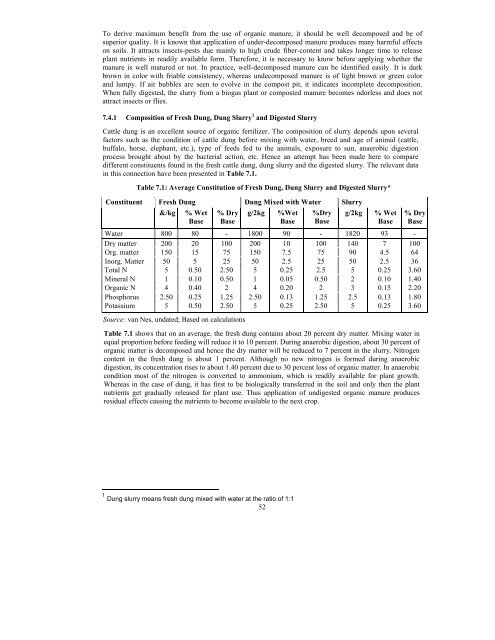download (pdf, 6MB) - SNV
download (pdf, 6MB) - SNV
download (pdf, 6MB) - SNV
You also want an ePaper? Increase the reach of your titles
YUMPU automatically turns print PDFs into web optimized ePapers that Google loves.
To derive maximum benefit from the use of organic manure, it should be well decomposed and be of<br />
superior quality. It is known that application of under-decomposed manure produces many harmful effects<br />
on soils. It attracts insects-pests due mainly to high crude fiber-content and takes longer time to release<br />
plant nutrients in readily available form. Therefore, it is necessary to know before applying whether the<br />
manure is well matured or not. In practice, well-decomposed manure can be identified easily. It is dark<br />
brown in color with friable consistency, whereas undecomposed manure is of light brown or green color<br />
and lumpy. If air bubbles are seen to evolve in the compost pit, it indicates incomplete decomposition.<br />
When fully digested, the slurry from a biogas plant or composted manure becomes odorless and does not<br />
attract insects or flies.<br />
7.4.1 Composition of Fresh Dung, Dung Slurry 1 and Digested Slurry<br />
Cattle dung is an excellent source of organic fertilizer. The composition of slurry depends upon several<br />
factors such as the condition of cattle dung before mixing with water, breed and age of animal (cattle,<br />
buffalo, horse, elephant, etc.), type of feeds fed to the animals, exposure to sun, anaerobic digestion<br />
process brought about by the bacterial action, etc. Hence an attempt has been made here to compare<br />
different constituents found in the fresh cattle dung, dung slurry and the digested slurry. The relevant data<br />
in this connection have been presented in Table 7.1.<br />
Constituent<br />
Table 7.1: Average Constitution of Fresh Dung, Dung Slurry and Digested Slurry*<br />
Fresh Dung Dung Mixed with Water Slurry<br />
&/kg<br />
% Wet<br />
Base<br />
% Dry<br />
Base<br />
g/2kg<br />
%Wet<br />
Base<br />
%Dry<br />
Base<br />
g/2kg<br />
% Wet<br />
Base<br />
% Dry<br />
Base<br />
Water 800 80 - 1800 90 - 1820 93 -<br />
Dry matter 200 20 100 200 10 100 140 7 100<br />
Org. matter 150 15 75 150 7.5 75 90 4.5 64<br />
Inorg. Matter 50 5 25 50 2.5 25 50 2.5 36<br />
Total N 5 0.50 2.50 5 0.25 2.5 5 0.25 3.60<br />
Mineral N 1 0.10 0.50 1 0.05 0.50 2 0.10 1.40<br />
Organic N 4 0.40 2 4 0.20 2 3 0.15 2.20<br />
Phosphorus 2.50 0.25 1.25 2.50 0.13 1.25 2.5 0.13 1.80<br />
Potassium 5 0.50 2.50 5 0.25 2.50 5 0.25 3.60<br />
Source: van Nes, undated; Based on calculations<br />
Table 7.1 shows that on an average, the fresh dung contains about 20 percent dry matter. Mixing water in<br />
equal proportion before feeding will reduce it to 10 percent. During anaerobic digestion, about 30 percent of<br />
organic matter is decomposed and hence the dry matter will be reduced to 7 percent in the slurry. Nitrogen<br />
content in the fresh dung is about 1 percent. Although no new nitrogen is formed during anaerobic<br />
digestion, its concentration rises to about 1.40 percent due to 30 percent loss of organic matter. In anaerobic<br />
condition most of the nitrogen is converted to ammonium, which is readily available for plant growth.<br />
Whereas in the case of dung, it has first to be biologically transferred in the soil and only then the plant<br />
nutrients get gradually released for plant use. Thus application of undigested organic manure produces<br />
residual effects causing the nutrients to become available to the next crop.<br />
1 Dung slurry means fresh dung mixed with water at the ratio of 1:1<br />
52
















